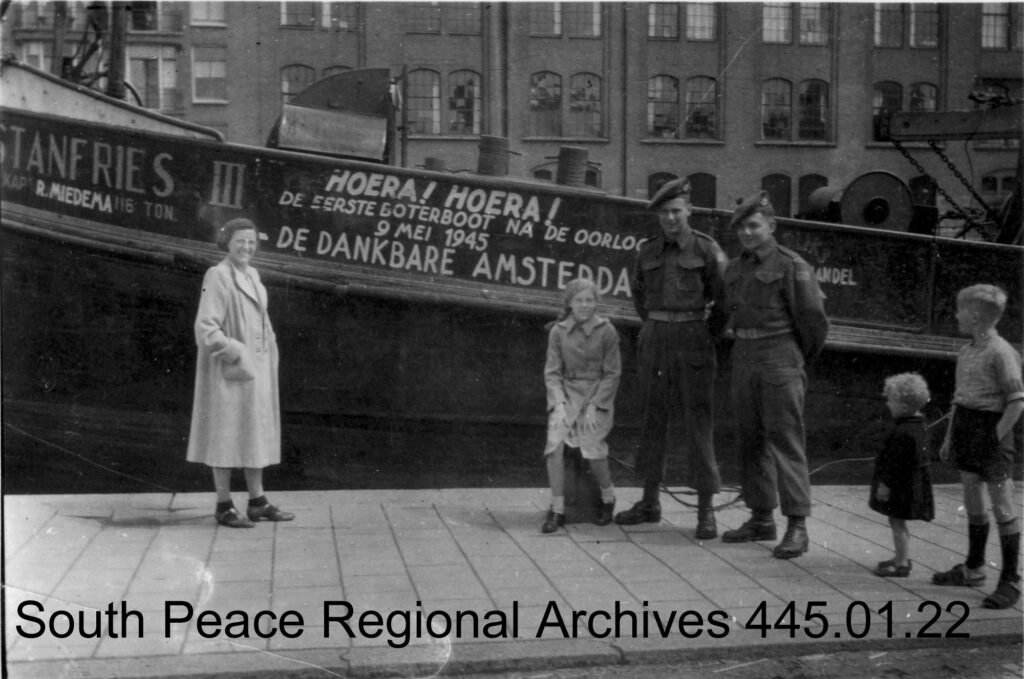Image: Ray Boyer, the soldier on the right, in Amsterdam in May, 1945. Behind is the first “Butter Boat” that arrived after the end of the war. (SPRA 445.01.22)
Regiment: Seaforth Highlanders – 1st Canadian Division
Regimental Number: K 737
Rank: Private
Ray Boyer was born December 11, 1924 in Grande Prairie, AB, and raised in East Kleskun on a farm on the south banks of Kleskun Lake (NE 35-72-4 W6). His father, Isaac, came to the Peace country from South Dakota and travelled over the Edson Trail in 1912. His mother, Bertha Delaney, a widow with six children, came to the Peace country from Ontario in 1919 and married Isaac Boyer. Along with his three- half sisters and three half-brothers, Ray also had an older brother, an older sister and a younger brother making up their family of ten children. Ray started his education in the East Kleskun School in 1930. The school was located 3.5 miles from their farm so it was a treat when he could ride a horse, especially in winter. Midway through grade school, Rays’s older brother, Clarence became the lead brother on the farm as their father was an invalid in his later years due to arthritis. Ray’s mother and the younger children were responsible for milking the cows, tending animals and other chores.
At the age of fifteen, Ray had to quit school and go to work to help support the family. One of his first jobs was to deliver water and ice to residences in Grande Prairie with a team of Pat Croken’s horses. He also remembers working in George Vagt’s Butcher Shop in Grande Prairie making wieners and sausage in a smoke house in the back alley. For the next three years Ray worked on different jobs including hauling gasoline up the Alaska Highway as far as Watson Lake. In 1943, Ray left for Vancouver and joined the Canadian Army. From Vancouver, he went to Wetaskiwin for Basic Training, then to Calgary for Advanced Training, and eventually to England where he took Signal Training. As a member of the Seaforth Highlanders First Division, Ray landed in Italy at Avaleno. From there Ray was sent to the front lines where troops relieved the Royal 22 Regiment of Quebec and Ray remembers seeing his first badly wounded soldier. They advanced north of Russi and in Bagnacavello, Italy, and in 1944 spent Christmas with a dinner in a church. At this time Ray was thrilled to meet up with his brothers Clarence and Archie close to the Senio River.
After Italy, the Highlanders were trucked to Holland. They crossed rivers in “Buffalos” which were floating tanks. Once after getting across, they were fired on and Ray remembers lying behind a dead cow for protection. They were continuing to advance through two towns in Holland when the news came that the Germans had surrendered. The Seaforths were then stationed in Amsterdam and Ray finally came home to Vancouver in May, 1946. Back in Grande Prairie, Ray worked different jobs: hauling lumber, working a dozer and a caterpillar and survey work. In 1953, Ray married Rita Robideau and they had three sons: Eldon, Doug and Arnie. Ray began working for the County of Grande Prairie in 1954 and remained there until 1985. He served on County Council, and numerous Boards including South Peace Health, Education, Planning, Evergreen Park, and the Agricultureal Society.
Ray wound down his career working as a Landman for Roy Northern working with landowners for approval of well sites, pipelines and right of ways. In 2000, Ray was the proud recipient of “Senior of the Year” from the Alberta Government. Ray has volunteered much of his retirement years developing the historic site at Kleskun Hill Museum. In 2001, Ray and his youngest son, Arnie, took a three week trip to Europe to revisit many of the sites he had been to during WWII.
Ray died in Grande Prairie on August 1, 2012.
Source: Rita Boyer
SPRA Family and Personal Life Reference Files (Obituary and news article)
Smoky River to Grande Prairie p. 119
Soldier Spotlight highlights veterans from the Archives’ online Soldiers’ Memorial. Each week, our volunteers select a remarkable individual to showcase in this blog series. The Soldiers’ Memorial commemorates more than 1,100 WWI veterans and 2,300 WWII veterans from our region. Three dedicated volunteers have contributed over 1,200 hours to this project by researching and writing biographies. Our goal is to have all South Peace soldiers acknowledged for their service. If you know of someone who lived in the South Peace and should be listed on the Memorial, or would like to get involved by researching a local veteran, please contact the Archives.
